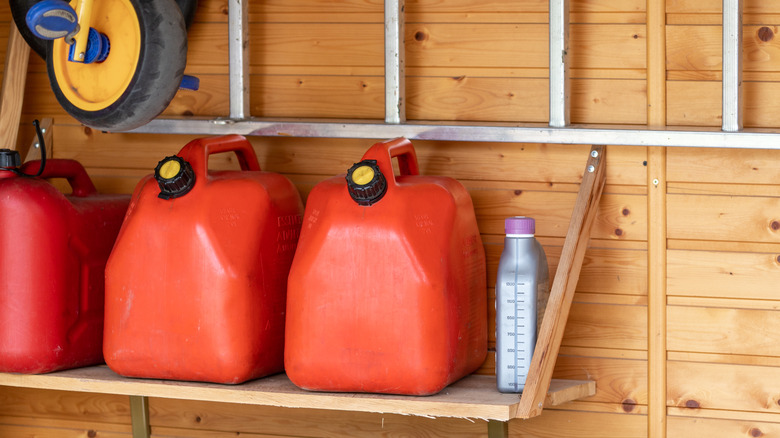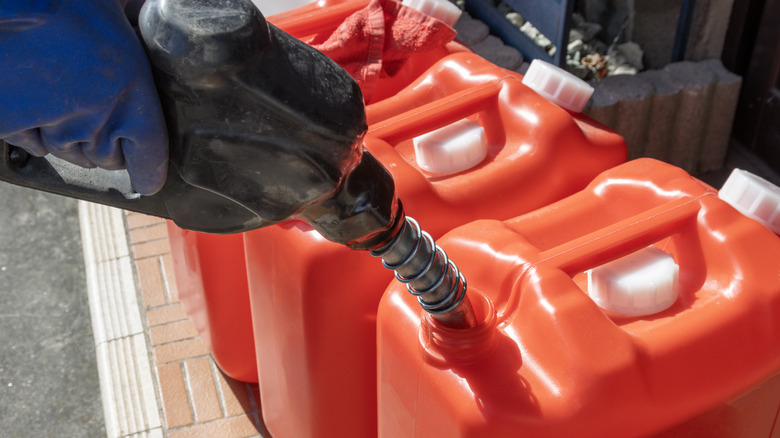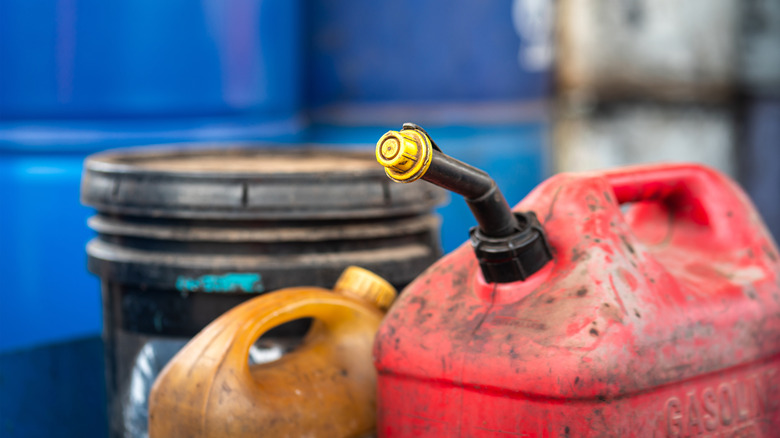Does Gasoline In A Container Have A Shelf Life? Here's What You Should Know
If you own gasoline-powered equipment like lawnmowers, chainsaws, or pressure washers, chances are, you have considered storing gasoline at home. But have you ever wondered how long it takes for gasoline stored in a container to go bad? In a previous article, SlashGear addressed how using a fuel stabilizer can help increase the life of gasoline stored inside the fuel tank of a car. But that is not the same environment as a storage container. We decided to investigate, and as it turns out, gasoline — just like its other fossil-fuel sibling, Diesel — does have a shelf life.
According to Exxon — one of the largest petrochemical companies on the planet — the ideal storage life of stored gasoline is a month. However, they do add that if the user adheres to good storage practices, they can store gasoline without noticeable loss in quality for up to six months. But this time frame appears to be only applicable for regular gasoline. If the gasoline you ended up storing has been blended with Ethanol, it could drastically reduce the life of the fuel. In fact, ethanol-blended gasoline has half the shelf life of regular gasoline and is only good for storage anywhere between one and three months.
British Petroleum, or BP, has a slightly different take on this. According to them, the life of gasoline is heavily dependent on how it is stored. If inside a sealed container, gasoline can last a year. Once the seal is broken, its shelf life reduces to six months if it is stored at a constant temperature of 68 degrees Fahrenheit. At higher temperatures, say 86 degrees Fahrenheit — the life is reduced further, to three months.
Why does stored gasoline go bad and how can you increase its life?
There are several reasons for stored gasoline to deteriorate over time. The most common reason is its interaction with atmospheric oxygen. The longer gasoline is stored in a container, the longer it is exposed to oxygen in the air. This exposure results in a gradual oxidation process, with the aftereffect being the formation of gummy deposits within the fuel. This reaction also reduces the combustibility of gasoline, reducing its overall effectiveness.
Even when stored inside a fuel tank that's reasonably sealed, BP estimates that by the end of week five, the fuel becomes 5% heavier, causing the engine to run richer and increasing the risk of damaging the engine. Another side effect of using this fuel is increased fuel consumption. Other factors that affect stored gasoline include temperature fluctuations and water contamination. While exposure to constant high temperatures may speed up oxidation, exposure to extreme cold can result in a phenomenon known as fuel separation.
Due to these reasons, it is not really a good idea to use "stale" gasoline in your cars and equipment. If you have a gas station within a reasonable distance from home, the best option would be to purchase the fuel as and when you need it. One of the ways in which you can increase the storage life of gasoline is to store the fuel in an area with little temperature variation. The second method is to add a fuel stabilizer to the stored gasoline. This additive slows down the breakdown process and reduces the degradation of the fuel over time.
Safety issues with gasoline storage
Another issue that concerns the storage of gasoline for extended periods of time is the safety aspect. Given the flammable nature of the fuel, the storage of gasoline is subject to a lot of regulations in the U.S. For example, under the NFPA 30 Flammable and Combustible Liquids Code, it's classified as a Class 1 flammable liquid.
Local regulations vary depending on where you live. In some cities, the maximum storage of combustible liquids like gasoline is restricted to 30 gallons, but only when it is stored in a shed unattached to the rest of the home. If stored in an attached garage, the total quantity should not exceed 10 gallons. Basements are strict no-go zones for storing gasoline. It is also mandatory that at least one approved fire extinguisher be placed between 10 and 50 feet from the location of the stored gasoline container.
Long-term storage of gasoline in containers comes with quality and safety-related caveats. Storing it for too long will almost certainly adversely affect the quality of gasoline. Storing it incorrectly also creates its own share of issues. It is essential, therefore, that these factors are kept in mind before deciding to store this volatile fuel on your property for extended periods of time.


